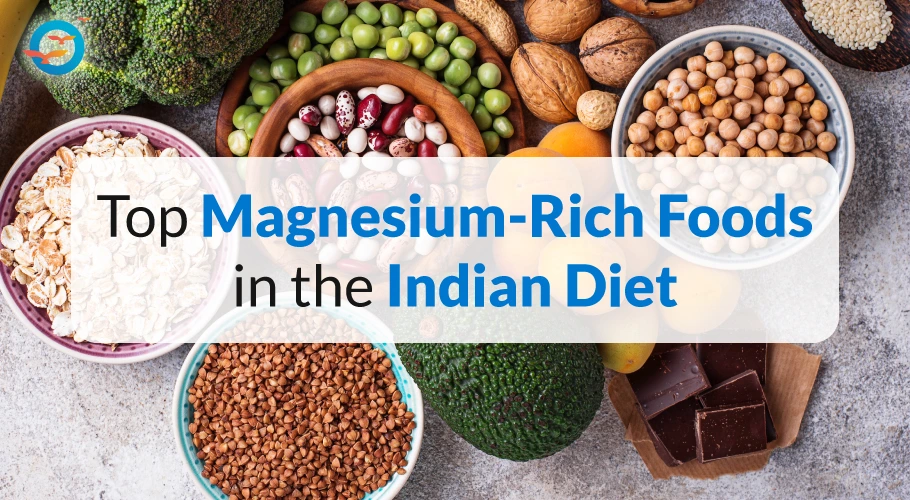Top Magnesium-Rich Foods in the Indian Diet

Top Magnesium-Rich Foods in the Indian Diet: Benefits, Sources & Tips
Magnesium is a vital mineral that supports energy production, muscle function, and blood sugar regulation. Yet, many people in India fail to meet their daily requirements because of diets heavy in refined grains and low in whole, nutrient-dense foods. This blog will highlight foods high in magnesium within an Indian context, offering an easy-to-follow magnesium rich foods list. You’ll learn about the benefits of magnesium rich foods, practical ways to include them, and answers to frequently asked questions.
What Is Magnesium and Why It Matters?
Magnesium is an essential mineral involved in over 300 biochemical processes helping with ATP production (energy), nerve transmission, muscle contraction, and regulating blood sugar levels. If you’re searching for dietary sources of magnesium, understanding its role can motivate you to seek out foods that contain magnesium.
Health Benefits of Magnesium
- Energy Metabolism & Reduced Fatigue: As a cofactor in ATP synthesis, magnesium helps convert food into usable energy.
- Muscle Relaxation & Prevention of Cramps: Adequate magnesium prevents muscle spasms and supports normal nerve function.
- Improved Insulin Sensitivity & Blood Sugar Control: Magnesium is crucial for glucose metabolism, making it a key mineral for those with or at risk of diabetes.
- Bone Health: It works alongside calcium and vitamin D to build strong bones.
- Stress & Sleep Regulation: Magnesium helps modulate neurotransmitters such as GABA, promoting relaxation and better sleep.
Signs & Risks of Magnesium Deficiency in Indian Populations
Common Deficiency Symptoms
- Muscle cramps and tremors
- Chronic fatigue and weakness
- Irritability, anxiety, or insomnia
- Irregular heartbeat
Contributing Factors in India
- Refined Grains: Diets high in white rice and maida lack the bran and germ that contain magnesium.
- Cooking Methods: Overboiling vegetables can leach minerals, so many leafy greens high in magnesium lose nutrients in discarded water.
- Lifestyle & Health: Stress, certain medications (like diuretics), and gastrointestinal issues can impair magnesium absorption.
Why It’s Relevant Today?
With rising rates of diabetes, hypertension, and metabolic syndrome across India, optimizing magnesium intake is more important than ever. Identifying the best dietary sources of magnesium can help counter these risks.
Top Magnesium-Rich Foods in the Indian Diet
Here is a magnesium rich foods list tailored to Indian cuisine. Each item includes approximate magnesium content per 100 g.
Nuts & Seeds:
- Pumpkin Seeds (Roasted) – 535 mg
- One of the best sources of magnesium, pumpkin seeds make an excellent snack or salad topping.
- Sprinkle on your smoothies or add to dosa batter for extra crunch.
- Almonds – 270 mg
- Almonds are a convenient food that contains magnesium.
- Eat a small handful as a mid-morning snack, or grind them into chutneys.
- Cashews – 260 mg
- Cashews rank high on any best foods for magnesium list.
- Use them in curries or roast with minimal salt.
- Sesame Seeds (Til) – 350 mg
- A staple in Indian kitchens, sesame seeds are a powerful dietary source of magnesium.
- Incorporate into laddoos, chutneys, or sprinkle over salads.
- Sunflower Seeds – 325 mg
- Sunflower seeds can easily be mixed into poha, upma, or mixed dals.
- Another excellent pick among top magnesium rich foods.
- Flax Seeds – 392 mg
- Flax seeds can be ground and added to smoothies, parathas, or chutney.
- Rich in omega-3 as well as magnesium, they’re a double-duty superfood.
- Peanuts (Dry Roasted) – 168 mg
- A budget-friendly food high in magnesium, peanuts can be eaten as a snack or used to prepare peanut chutney.
Legumes and Pulses
- Soybeans (Boiled) – 86 mg
-
- Whether as edamame or in curries, soybeans are a versatile dietary source of magnesium.
2. Rajma (Kidney Beans, Boiled) – 45 mg
-
- Rajma is a beloved Punjabi staple and a decent food that contains magnesium.
- Enjoy rajma with chawal or rajma curry.
3. Black Gram (Urad Dal, Boiled) – 57 mg
-
- Used in idli, dosa, and papad, urad dal adds both protein and magnesium to the diet.
4. Tofu (Soy Paneer) – 30–50 mg
-
- A good vegetarian source of magnesium, tofu also provides complete plant-based protein.
- Try in curries or stir-fries.
Leafy Greens and Vegetables
- Spinach (Palak, Boiled) – 87 mg
-
- Among leafy greens high in magnesium, spinach is easy to cook—lightly sauté or steam to retain minerals.
2. Amaranth Leaves (Chaulai) – 55 mg
-
- A traditional green, chaulai is often prepared as a sabzi or added to dal.
3. Methi (Fenugreek Leaves) – 54 mg
-
- Methi leaves, rich in both flavour and magnesium, can be used in methi paratha or methi sabzi.
4. Bhindi (Okra, Cooked) – 57 mg
-
- Okra is high in fiber and a moderate source of magnesium.
- Roast or sauté to preserve nutrients.
Whole Grains and Millets
1. Whole Wheat Flour (Atta) – 140 mg
- Replacing refined flour with whole wheat is an easy way to boost intake.
- Each atta chapati delivers a modest but meaningful amount of magnesium.
2. Ragi (Finger Millet) – 137 mg
-
- A staple in South India, ragi is one of the best sources of magnesium in millet form.
- Enjoy ragi dosa, ragi porridge, or ragi roti.
3. Brown Rice (Cooked) – 44 mg
-
- A simple switch from white rice to brown rice adds magnesium to everyday meals.
4. Jowar (Sorghum) – 130 mg
-
- Jowar roti is a popular alternative to wheat roti, offering a higher magnesium content.
5. Bajra (Pearl Millet) – 137 mg
-
- Bajra roti or khichdi is another fantastic dietary source of magnesium.
Fruits
- Banana – 27 mg
-
- While not as dense as seeds or nuts, bananas are a convenient fruit high in magnesium.
- Eat alone or blend into a smoothie.
Other Superfoods
- Dark Chocolate (70–85%) – 228 mg
-
- In moderation, dark chocolate is a delicious best source of magnesium.
- Choose varieties with minimal sugar for maximum benefit.
How to Maximize Magnesium Absorption
- Soaking & Sprouting
- Soak legumes (e.g., moong dal, rajma), Almonds and seeds (pumpkin, sunflower) overnight to reduce phytic acid, improving mineral absorption.
- Cooking Techniques
- Lightly steam or sauté leafy greens high in magnesium like spinach and methi rather than boiling excessively.
- Retain cooking water as a broth for soups or dals to recapture leached minerals.
- Pairing with Supporting Nutrients
- Vitamin D–rich foods (sun-exposed mushrooms) enhance magnesium’s role in bone health.
- Avoid consuming high doses of calcium supplements simultaneously, as calcium can compete with magnesium for absorption.
Conclusion
Magnesium plays a crucial role in energy, muscle function, and blood sugar balance. By choosing foods high in magnesium such as millets, legumes, nuts, seeds, and green vegetables you can vastly improve your overall health. Start making simple swaps today: replace white rice with brown rice, add a handful of nuts or seeds to your snacks, and incorporate spinach or methi into your dals and sabzis.
Read more about Multigrain atta for diabetes, visit our blog
FAQs
What are the top magnesium-rich foods?
Pumpkin seeds, almonds, cashews, sesame seeds, flax seeds, spinach, ragi, and bajra are among the best sources of magnesium.
Which Indian foods are high in magnesium?
Millets (ragi, bajra, jowar), legumes (rajma, moong dal), nuts (almonds, cashews), seeds (pumpkin, sesame, flax), and leafy greens (spinach, methi, chaulai).
What are the best dietary sources of magnesium?
Nuts and seeds lead the magnesium rich foods list, followed by millets, whole grains, legumes, and dark leafy vegetables.
How can I increase my magnesium intake naturally?
Incorporate foods high in magnesium into daily meals, soak and sprout legumes/seeds, lightly cook leafy greens, and choose whole grains over refined varieties.
What are the health benefits of magnesium-rich foods?
They support energy production, muscle relaxation, blood sugar regulation, bone health, and stress reduction.
What are the symptoms of magnesium deficiency?
Fatigue, muscle cramps, irritability, insomnia, and irregular heartbeat.
Do fruits, vegetables, and nuts contain magnesium?
Yes. Bananas, avocados, leafy greens (spinach, methi), almonds, walnuts, cashews, and seeds (pumpkin, flax, sesame) are excellent foods that contain magnesium

